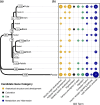Chromosome-scale Genomes Show Rapid Diversification and Ancient Gene Flow Among Bear Species
- PMID: 41047635
- PMCID: PMC12631120
- DOI: 10.1093/gbe/evaf188
Chromosome-scale Genomes Show Rapid Diversification and Ancient Gene Flow Among Bear Species
Abstract
Reconstructions of evolutionary history can be restricted by a lack of high-quality reference genomes. To date, only four of the eight species of bears (family Ursidae) have chromosome-level genome assemblies. Here, we present assemblies for three additional species-the sun, sloth, and Andean bears-and use a whole-genome alignment of all bear species and other carnivores to reconstruct the evolution of Ursidae. Multiple divergence dating approaches suggest that the six Ursine bears likely diversified in the last 5 Ma, but that divergence times within Ursinae are significantly impacted by gene tree heterogeneity. Consistent with this, we observe that nearly 50% of gene trees conflict with our highly supported species tree, a pattern driven by a significant early hybridization event within Ursinae. We also find that the karyotype of Ursinae is largely similar to the ancestral karyotype of all bears twenty million years prior. In contrast to this conservation of structure, dozens of chromosomal fissions and fusions associated with LINE/L1 retrotransposons dramatically restructured the genomes of the giant panda and Andean bear. Finally, we leverage these genomes to identify species-specific evidence for positive selection on genes associated with color, diet, and metabolism. One of these genes, TCPN2, has a role in pigmentation and shows a series of amino acid mutations in the polar bear over the last 0.5 Ma. Collectively, these new genomic resources enable improved reconstruction of the complex evolutionary history of bears and clarify how this enigmatic group diversified.
Keywords: bears; chromosome evolution; gene flow; phylogenomics; positive selection.
© The Author(s) 2025. Published by Oxford University Press on behalf of Society for Molecular Biology and Evolution.
Conflict of interest statement
Conflict of Interest: The authors declare no conflict of interests.
Figures





References
MeSH terms
Grants and funding
LinkOut - more resources
Full Text Sources

